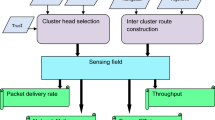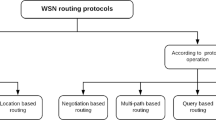Abstract
In multihop scenarios, the sensor nodes nearer to the base station (BS) are overloaded because they handle their own data as well as the information obtained from far away nodes. This induces a higher energy depletion rate in nodes near to the BS causing early death of these nodes resulting in hot spot/energy hole problem in wireless sensor network (WSN). This paper proposes a novel strategy using unequal fixed grid-based cluster along with a mobile data mule for data collection from the cluster head (CH). A CH is selected in such a manner that the cumulative transmission distance for member nodes within the cluster is minimum. The paper has attempted to optimize the values for CH change time or round number (f) and also established a relationship between different size clusters by using a factor (r), as they are playing an important role in the overall performance improvement of the WSN. Integrating a mobile data mule in the protocol enhances its efficiency of handling hot spot problem and makes it more energy effective. Two different WSN-scenarios have been considered based on the movement pattern of the data mule. The results obtained through simulation in both scenarios prove the success of our scheme in terms of energy efficiency, load balancing and network lifetime as compared to the existing protocols. The paper also providing a balance trade-off between delay and high overheads by using a single mule with simple predefined path. It also minimizes the hot spot problem as it sustains more than 3000 rounds, which is far better than the existing methods.













Similar content being viewed by others
Change history
13 August 2018
The Acknowledgement section was missing in the original publication. It is provided below.
References
Akyildiz, I. F., Su, W., Sankarasubramaniam, Y., & Cayirci, E. (2002). Wireless sensor networks: A survey. Computer Networks, 38(4), 393–422.
Alsalih, W., Hassanein, H., & Akl, S. (2010). Placement of multiple mobile data collectors in wireless sensor networks. Ad Hoc Networks, 8(4), 378–390.
Amrutha, K. M., Ashwini, P., Raj, D. K., Kavitha, R. G., & Mundada, M. R. (2013). Energy efficient clustering and grid based routing in wireless sensor networks. In International conference on advances in computing (pp. 69–74). Springer.
Anastasi, G., Conti, M., & Di Francesco, M. (2009). Reliable and energy-efficient data collection in sparse sensor networks with mobile elements. Performance Evaluation, 66(12), 791–810.
Asharioun, H., Asadollahi, H., Wan, T.-C., & Gharaei, N. (2015). A survey on analytical modeling and mitigation techniques for the energy hole problem in corona-based wireless sensor network. Wireless Personal Communications, 81(1), 161–187.
Bandyopadhyay, Seema., & Coyle, Edward J. (2003). An energy efficient hierarchical clustering algorithm for wireless sensor networks. In INFOCOM 2003 (Vol. 3, pp. 1713–1723). IEEE.
Khurana Batra, P., & Kant, K. (2016). LEACH-MAC: A new cluster head selection algorithm for wireless sensor networks. Wireless Networks, 22(1), 49–60.
Di Francesco, M., Das, S. K., & Anastasi, G. (2011). Data collection in wireless sensor networks with mobile elements: A survey. ACM Transactions on Sensor Networks (TOSN), 8(1), 7.
Fadel, E., Gungor, V. C., Nassef, L., Akkari, N., Abbas Maik, M. G., Almasri, S., et al. (2015). A survey on wireless sensor networks for smart grid. Computer Communications, 71, 22–33.
Farooq, Muhammad Omer, Dogar, Abdul Basit, & Shah, Ghalib Asadullah. (2010). Mr-leach: Multi-hop routing with low energy adaptive clustering hierarchy. In 24 international conference on sensor technologies and applications (SENSORCOMM), (pp. 262–268). IEEE.
Gao, T., Jin, R. C., Song, J. Y., Xu, T. B., & Wang, L. D. (2012). Energy-efficient cluster head selection scheme based on multiple criteria decision making for wireless sensor networks. Wireless Personal Communications, 63(4), 871–894.
Guiloufi, A. B. F., Nasri, N., & Kachouri, A. (2016). An energy-efficient unequal clustering algorithm using ‘sierpinski triangle’ for wsns. Wireless Personal Communications, 88(3), 449–465.
Harold Robinson, Y., Golden Julie, E., Balaji, S., & Ayyasamy, A. (2016). Energy aware clustering scheme in wireless sensor network using neuro-fuzzy approach. Wireless Personal Communications, 1–19.
Heinzelman, W. B., Chandrakasan, A. P., & Balakrishnan, H. (2002). An application-specific protocol architecture for wireless microsensor networks. IEEE Transactions on wireless communications, 1(4), 660–670.
Heinzelman, Wendi Rabiner, Chandrakasan, Anantha, & Balakrishnan, Hari. (2000). Energy-efficient communication protocol for wireless microsensor networks. In Proceedings of the 33rd annual Hawaii international conference on System sciences, 2000. (pp. 01–10). IEEE.
Huang, J.-H., Zhao, Z.-M., Yuan, Y.-B., & Hong, Y.-D. (2017). Multi-factor and distributed clustering routing protocol in wireless sensor networks. Wireless Personal Communications, 95(3), 2127–2142.
Jain, S., Shah, R. C., Brunette, W., Borriello, G., & Roy, S. (2006). Exploiting mobility for energy efficient data collection in wireless sensor networks. Mobile Networks and Applications, 11(3), 327–339.
Jannu, S., & Jana, P. K. (2015). A grid based clustering and routing algorithm for solving hot spot problem in wireless sensor networks. Wireless Networks, 22(6), 1901–1916.
Jin, Y., Wang, L., Kim, Y., & Yang, X. (2008). Eemc: An energy-efficient multi-level clustering algorithm for large-scale wireless sensor networks. Computer Networks, 52(3), 542–562.
Khan, J. A., Qureshi, H. K., & Iqbal, A. (2015). Energy management in wireless sensor networks: A survey. Computers & Electrical Engineering, 41, 159–176.
Kim, Jung-Hwan, Chauhdary, Sajjad Hussain, Yang, Wen-Cheng, Kim, Dong-Sub, & Park, Myong-Soon. (2008). Produce: a probability-driven unequal clustering mechanism for wireless sensor networks. In 22nd international conference on advanced information networking and applications (pp. 928–933). IEEE.
Muthu Krishnan, A., & Ganesh Kumar, P. (2015). An effective clustering approach with data aggregation using multiple mobile sinks for heterogeneous WSN. Wireless Personal Communications, 90(2), 423–434.
Lee, S., Choe, H., Park, B., Song, Y., & Kim, C. (2011). Luca: An energy-efficient unequal clustering algorithm using location information for wireless sensor networks. Wireless Personal Communications, 56(4), 715–731.
Liu, W.-d., Wang, Z.-d., Zhang, S., & Wang, Q.-q. (2010). A low power grid-based cluster routing algorithm of wireless sensor networks. In 2010 international forum on information technology and applications (IFITA) (Vol. 1, pp. 227–229). IEEE.
Luo, J., & Hubaux, J.-P. (2005). Joint mobility and routing for lifetime elongation in wireless sensor networks. In Proceedings IEEE 24th annual joint conference of the IEEE computer and communications societies (Vol. 3, pp. 1735–1746). IEEE.
Majma, M. R., Pedram, H., & Dehghan, M. (2014). Igbdd: Intelligent grid based data dissemination protocol for mobile sink in wireless sensor networks. Wireless Personal Communications, 78(1), 687–714.
Mann, P. S., & Singh, S. (2017). Energy-efficient hierarchical routing for wireless sensor networks: A swarm intelligence approach. Wireless Personal Communications, 92(2), 785–805.
Mantri, D., Prasad, N. R., & Prasad, R. (2014). Two tier cluster based data aggregation (ttcda) for efficient bandwidth utilization in wireless sensor network. Wireless Personal Communications, 75(4), 2589–2606.
Mantri, D. S., Prasad, N. R., & Prasad, R. (2016). Mobility and heterogeneity aware cluster-based data aggregation for wireless sensor network. Wireless Personal Communications, 86(2), 975–993.
Mishra, R., Jha, V., Tripathi, R. K., & Sharma, A. K. (2017). Energy efficient approach in wireless sensor networks using game theoretic approach and ant colony optimization. Wireless Personal Communications, 95(3), 3333–3355.
Pantazis, N. A., Nikolidakis, S. A., & Vergados, D. D. (2013). Energy-efficient routing protocols in wireless sensor networks: A survey. IEEE Communications Surveys & Tutorials, 15(2), 551–591.
Prince, B., Kumar, P., Singh, M. P., & Singh, J. P. (2016). An energy efficient uneven grid clustering based routing protocol for wireless sensor networks. In IEEE conference on Wireless Communications, Signal Processing and Networking (WiSPNET) (pp. 1624–1628).
Aravindh, P., Sasikala, S. D., & Sangameswaran, N. (2015). Improving the energy efficiency of leach protocol using VCH in wireless sensor network. International Journal of Engineering Development and Research, 3(2), 918–924.
Shah, R. C., Roy, S., Jain, S., & Brunette, W. (2003). Data mules: Modeling a three-tier architecture for sparse sensor networks. In 2003 IEEE international workshop on sensor network protocols and applications, 2003. Proceedings of the first IEEE (pp. 30–41), May 2003.
Singh, S. K., Kumar, P., & Singh, J.P. (2016). An energy efficient odd-even round number based data collection using mules in WSNs. In 2016 international conference on wireless communications, signal processing and networking (WiSPNET) (pp. 1255–1259). March 2016.
Singh, S. K., Kumar, P., & Singh, J. P. (2017). A survey on successors of leach protocol. IEEE Access, 5, 4298–4328.
Sugihara, R., & Gupta, R. K. (2010). Optimal speed control of mobile node for data collection in sensor networks. IEEE Transactions on Mobile Computing, 9(1), 127–139.
Varga, A., & Hornig, R. (2008, March). An overview of the OMNeT++ simulation environment. In Proceedings of the 1st international conference on Simulation tools and techniques for communications, networks and systems & workshops (p. 60). ICST (Institute for Computer Sciences, Social-Informatics and Telecommunications Engineering).
Younis, O., & Fahmy, S. (2004). Heed: a hybrid, energy-efficient, distributed clustering approach for ad hoc sensor networks. IEEE Transactions on mobile computing, 3(4), 366–379.
Jiguo, Y., Qi, Y., Wang, G., & Xin, G. (2012). A cluster-based routing protocol for wireless sensor networks with nonuniform node distribution. AEU—International Journal of Electronics and Communications, 66(1), 54–61.
Zhao, W., Ammar, M., & Zegura, E. (2004). A message ferrying approach for data delivery in sparse mobile ad hoc networks. In 5th ACM international symposium on mobile ad hoc networking and computing (pp. 187–198). ACM.
Author information
Authors and Affiliations
Corresponding author
Additional information
Publisher's Note
Springer Nature remains neutral with regard to jurisdictional claims in published maps and institutional affiliations.
Rights and permissions
About this article
Cite this article
Singh, S.K., Kumar, P. & Singh, J.P. An Energy Efficient Protocol to Mitigate Hot Spot Problem Using Unequal Clustering in WSN. Wireless Pers Commun 101, 799–827 (2018). https://doi.org/10.1007/s11277-018-5716-3
Published:
Issue Date:
DOI: https://doi.org/10.1007/s11277-018-5716-3




